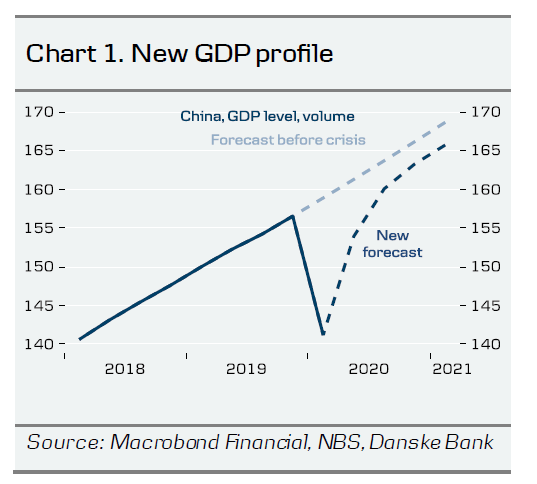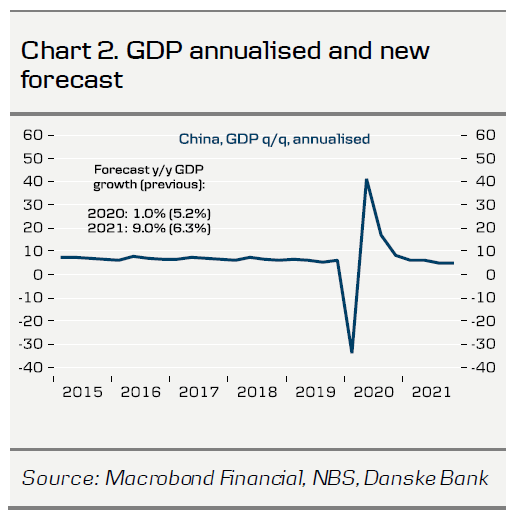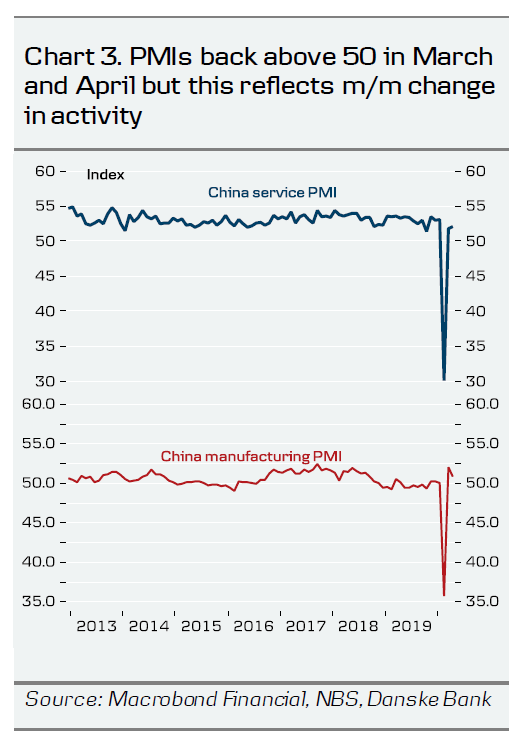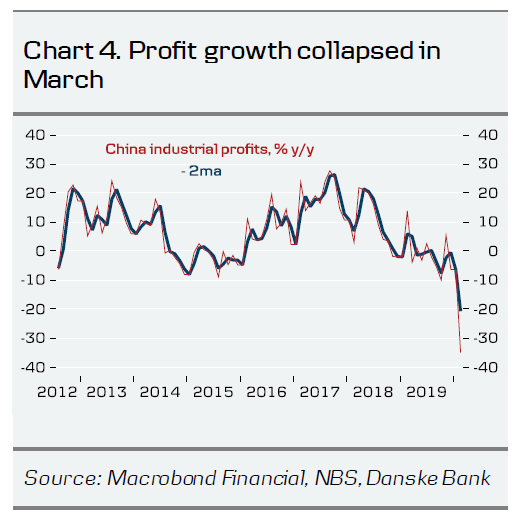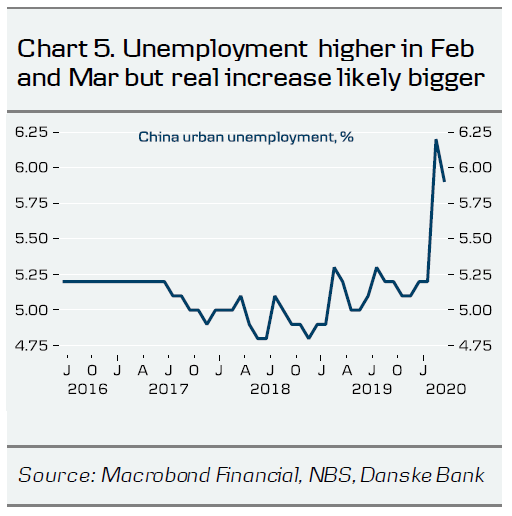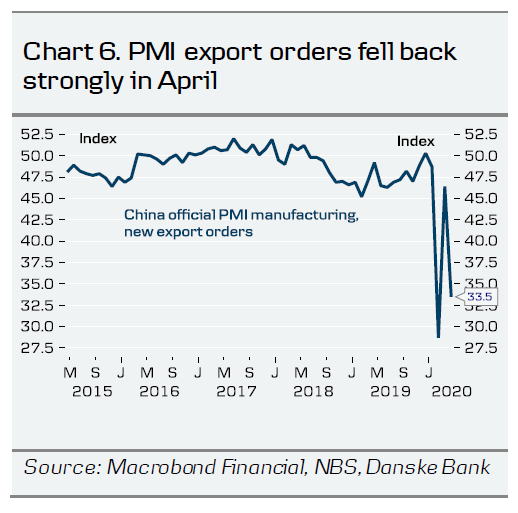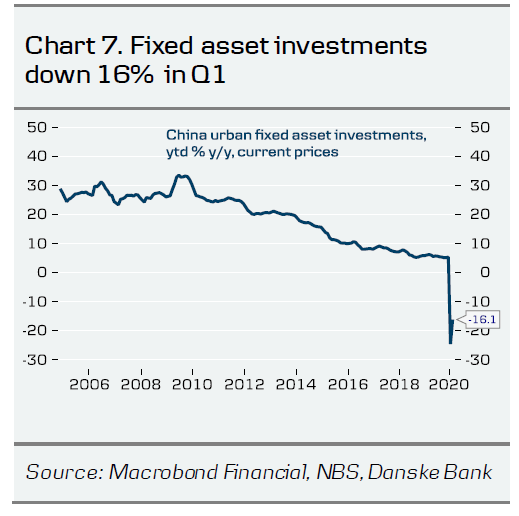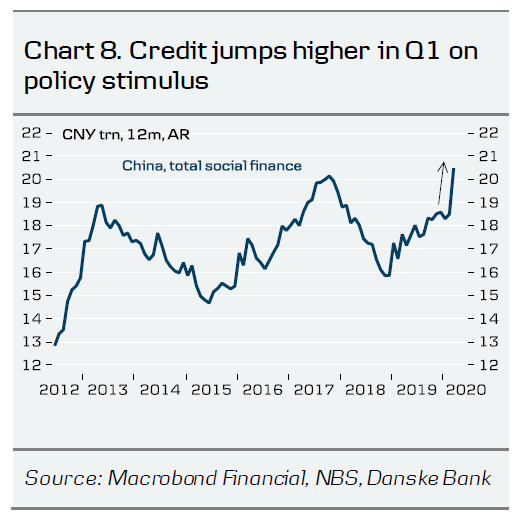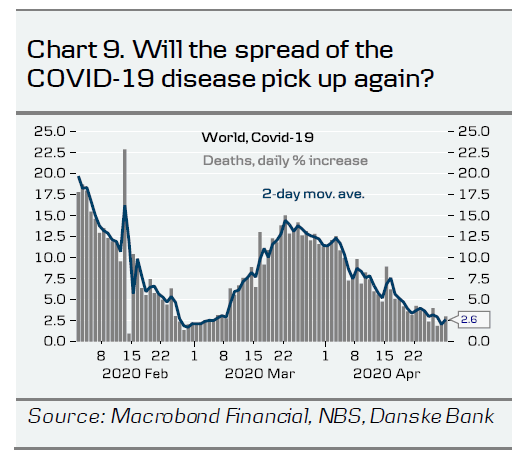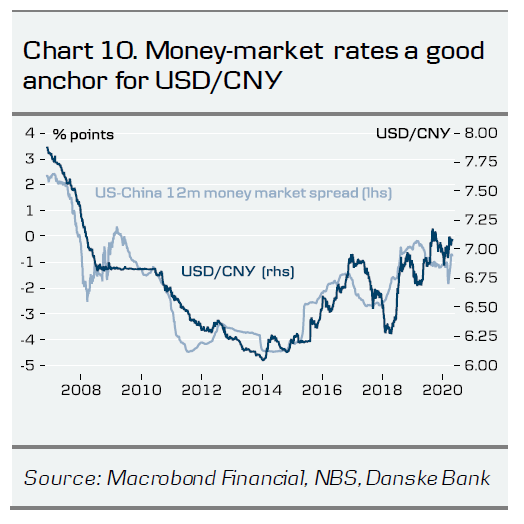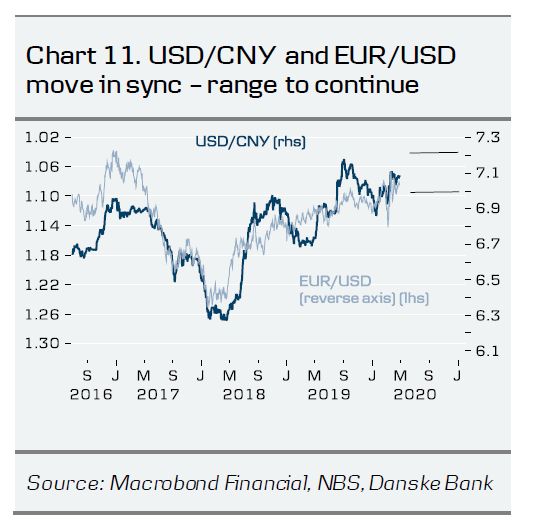- China’s production has bounced back but we expect demand to be weak for some time due to still high uncertainty and a hit to external demand. We expect construction and infrastructure to provide the main support.
- Following the plunge in Q1 GDP, we now look for economic growth to be 1.0% in 2020 (previously 5.2%) but to rebound to 9.0% in 2021 (previous 6.3%). We expect the government to add more economic stimulus but to do so in a measured way. We do not expect a significant stimulus package such as in 2008/09.
- USD/CNY has stabilised. We look for a 7.0-7.20 range over the next six months.
How much has China returned to normal life?
With China being the first country both to enter and to exit the COVID-19 cycle, the country can serve as an indication of what to expect when other countries open up. Many uncertainties loom. How quickly will people return to shops and restaurants? How much of the money saved during the lockdown will people spend afterwards? How fast will factories get up to speed again? It is still early days and data is far from perfect. However, based on what is available and anecdotal evidence, the following picture emerges in China
A very gradual return to normal. A survey by FleishmanHillard done around 1 April showed that Chinese people expected it to be nine weeks before life returned to normal. This would mean by early June. Based on anecdotal evidence, life is already getting closer to normal in places such as Shanghai, where people are increasingly going out to bars, restaurants and shops again. In Beijing, however, things are tighter and the return to normal is taking longer. Other cities seem to be somewhere in between. Social distancing and hygiene are very much in focus still and many are working from home. Most people wear masks when going out. Generally, while life is gradually normalising, there is still a good way to go to get back to normal. The recent occurrence of new infections in some cities has served as a reminder that the crisis is not over and is keeping people on their toes. One indication of this is the picture from congestion data in the big cities. On weekdays, congestion levels are close to normal but at weekends, they are still far below pre-coronavirus outbreak levels. On a more positive note, the China Economic Recovery Index from WeBank (a Tencent company) increased a bit on Saturdays in April, from 67.8% on 4 April to 73.8% on 11 April. This suggests to us that things are gradually improving.
Across China, a coloured QR code on people’s phone now indicates whether they are safe or in the risk group and determines whether they can get access to shops, restaurants and so on. The colour is based on their travel history, whether they have been in contact with any confirmed or suspected patients in the past two weeks and whether they have recently had any symptoms, such as fever, cough or sore throat. The code, which is scanned when entering shops, restaurants and so on also helps to track people who have been close to a person diagnosed with COVID-19.
Production closer to normal. In late March, the official estimates were that 99% of large enterprises and more than 80% of smaller ones had reopened. PMI manufacturing, which measures change in production, rebounded strongly in March from 35.7 to 52.0 but fell back slightly in April to 50.8. Industrial production for March was down 1.1% compared with a year ago, which also suggests that production was close to having caught up to normal levels. Coal consumption has increased and is now only around 5% lower than a year ago. It was down 35% in February.
Retail and restaurants still suffering. The Ministry of Commerce reported that 96% of department stores and 80% of restaurants are open. However, revenues are still around half of 2019’s level. Retail sales fell 20% y/y in January/February and increased only slightly in March to -15% y/y. Car sales in April are still 25% lower than in April 2019. E-commerce has picked up, as people are going out less but not enough to compensate for the decline in bricks-and-mortar stores. The numbers suggest that although people have extra money sitting in their accounts from not spending much in the first two months, they are reluctant to go out and consume. Uncertainty about unemployment and the risks of another outbreak are keeping consumers cautious.
Transportation. China’s domestic flights are back to around half of pre-crisis levels, helped partly by airlines offering deals at very low prices.
Housing is improving but has not normalised. Property sales were still down 30% y/y in mid-April (up from a decline of 72% in February). Prices have not fallen much though, which may be due to low turnover and people not wanting to sell at a big discount in anticipation of better times over the next one to two years. With sales under pressure, residential construction has also been hit. Housing starts were down 10% y/y in March. The government has doubled the target for renovation this year to underpin demand.
Infrastructure investment increased. While the infrastructure stimulus is more moderate than the big leap in 2008/09, there are many signs China has ramped up infrastructure investment quite a bit. First, issuance of special purpose bonds increased from CNY717bn in Q1 19 to CNY1,104bn in Q1 20, a 54% increase. Second, sales of excavators increased 12% y/y in March and leading heavy equipment makers have announced price increases of 5-10%.
Exports under pressure. The official export data for March surprised on the upside but the data looked a bit off and the deep recessions in the US and Europe are likely to cause a sharp decline in exports in the short term. The PMI export order index for March stayed below 50.0 at 46.4 and fell back strongly again in April to 33.5, signalling a clear contraction in exports.
Profit growth in reverse. Industrial profits fell 34.9% in March. This compares with an average rate of close to +10% over the past seven to eight years.
Unemployment. The surveyed urban unemployment rate increased to 6.2% in February, from around 5% in late 2019, and fell back to 5.9% in March. However, actual unemployment is likely to increase more quickly as many businesses are going bankrupt and private demand has fallen significantly. EIU estimated in a recent report that 22 million urban workers will lose their job, pushing the unemployment rate to 10%.
GDP plunged in Q1, recovery set to take time
Judging from the anecdotal evidence and high frequency data for April, the return to normal is likely to take time. GDP collapsed by 8.6% y/y in Q1 and while the more mechanical rebound in production and sales from deeply depressed levels will push up GDP in Q2, we believe underlying demand will take time to recover fully.
- We expect consumers to worry about unemployment, especially as the Chinese social benefit system is still not fully developed. There also seems to be a mismatch between those who hold unemployment insurance and those who need it. Up to 50 million migrant workers are estimated to have lost their jobs and they need to return to their home county where they have hukou registration to claim benefits. Instead, many have chosen to remain in the city and search for a job. On top of the uncertainty of high unemployment, overall income levels are set to fall as laid-off workers face a loss in salary that unemployment benefits do not fully compensate. Some ‘revenge sp ending’ to support businesses may take place but we doubt it will be forceful enough to drive a fast revival of consumer spending.
- Companies are also likely to be cautious for some time and many businesses will be more or less in survival mode to get through the crisis without going bankrupt. This is not the time for big investments but rather for keeping costs slim and, if possible, building a cash buffer to increase resilience in the case of a prolonged crisis.
- On top of weak consumer demand, exporters face a tough time ahead, with the developed economies in deep recession in the short term. In our view, emerging markets outside China will also face headwinds with many of them exposed to the commodity markets, where prices have plummeted and demand has plunged.
We believe the main pillar of support in the short term will continue to be policydriven demand from higher infrastructure spending and other construction projects. However, in our view, this will only partly fill the gap. The overall policy stimulus is broad based, including many different discretionary measures aimed at small and medium-sized businesses, including tax cuts, reductions in fees, rate cuts and so on. The IMF estimates that the total fiscal stimulus will end up around 5% of GDP including measures already taken and new initiatives to come. We lean towards this estimate as well.
A revision of the GDP forecast has been long overdue since the big plunge in Q1. On the back of the above arguments, we lower our projection for 2020 to 1.0% (from 5.2%) and lift our projection for 2021 to 9.0% (up from 6.3%). We depict the profile in charts 1 and 2 on the front page of this document. We expect a V-shaped recovery due to the sharp decline in Q1 but as shown in Chart 1, we still expect the GDP level in 2021 to be below what it would have been without the COVID-19 crisis. Nevertheless, this still implies a 9.0% growth rate in 2021.
Our projection is close to that depicted by the IMF in its spring forecast. It looks for 1.2% in 2020 and 9.2% in 2021.
Key factors: second wave, vaccine, bankruptcies and savings
We are clearly in uncharted territory with low visibility, so any forecast is highly uncertain. What is more important, in our view, is the story line: It is a major short-term hit and the climb out of the hole is likely to be gradual. However, the path depends on many things. In our view, its key determinants, both in China and globally, will be as follows.
Will there be a second wave? If it turns out that the US and countries in Europe open up too soon and too fast, we could quickly face a second wave, with the risk new restrictions will have to be imposed and people staying away from shops again. We may also have some months of calm but see a second wave later in the year. The US CDC has warned of the difficulties if a second wave coincides with the flu season starting in November, as the strain on hospitals could be significant.
Will an effective treatment be found? Related to the possibility of a second wave is the search for an effective treatment. Several products are currently undergoing trials, with results set to come over the next zero to six months. Finding an effective drug could lower the mortality rate and allow more space to let the virus spread and a faster return to normal life. This could pave the way for a faster recovery.
When will we have a vaccine? If no effective treatment is found, the timing of a vaccine is important for when we can get closer to normal life. More than 100 trials are ongoing and the most optimistic scenario is that a vaccine for emergency use could be ready in the autumn. However, it could also take more than a year and thus extend the period of social-distancing measures, with negative effects on the economy.
How many companies will go bankrupt? The current economic meltdown is the worst since World War II and many companies are fighting for survival. The longer the crisis drags on, the more cash buffers will be depleted and more bankruptcies are likely to occur. In turn, this could push up unemployment further and depress private consumption.
Will we see ‘revenge spending’? The term ‘revenge sp ending’ has emerged in China to express a collective push for consumers to spend some of the money saved to support the companies that are struggling because of the crisis. It is very uncertain how much of this we will see but if it takes off, it could potentially lead to a stronger rebound in economies, both in China and in other countries.
CNY set to stay in a broadly stable range
Despite the high volatility in financial markets since late February, the CNY has been remarkably stable. While many emerging market currencies have been under significant pressure, this has not been the case for CNY. China has not experienced the same amount of outflow pressure and the Chinese stock market is one of the best performing in the world this year. The main reason is probably that China is further on in the virus cycle. So, while other emerging market countries and many developed countries are still in lockdown, China has started the journey towards normal life and managed to keep new infections under control despite a pickup in imported cases in April.
While money-market rates have fallen substantially in China as reductions in reserve requirement ratios have freed up liquidity, the rate cuts by the Fed in the US have also pushed down money-market rates here. The difference between money-market rates has moved in favour of the CNY over the past year and helps to anchor USD/CNY.
Generally, USD/CNY has moved closely in sync with the overall USD development. As we look for EUR/USD to be broadly stable over the next 12 months, with a slight strengthening bias, we also expect USD/CNY to remain range bound between 7.0 and 7.2. This implies that we look for EUR/CNY to stay in a narrow range of 7.6-7.9.




